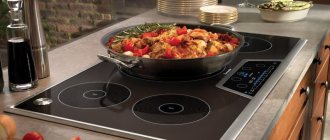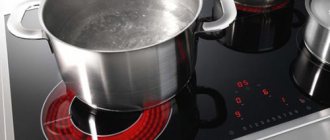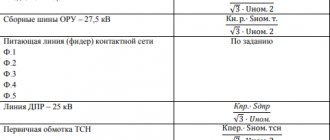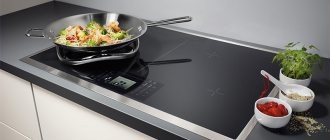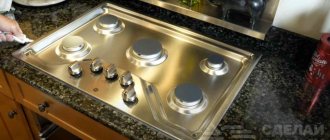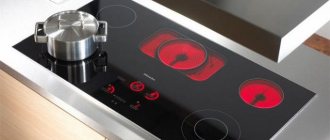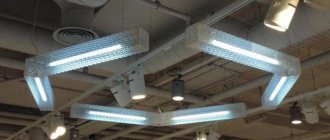An induction hob is one of the most modern options for kitchen appliances. It is considered not only safe, but also beneficial to use. Although, despite its efficiency, the power of the stove is quite high.
Induction panels are more efficient than electric stoves, but help save energy. You can understand how this happens by considering not only the indicators of different types of equipment, but also the principles of their operation.
About the induction cooker
The main functions of the equipment, heating and maintaining heat, are performed by a magnetic field. This increases the speed of cooking, makes the process economical, and provides a number of other advantages.
The dishes turn out juicier and almost do not burn. Therefore, such slabs are worth buying, even taking into account their higher price. Moreover, their operation can be made even more profitable.
Principle of operation
The induction panel differs in the way it transfers heat to the cookware. On electric or gas stoves, the burner heats up first, then the frying pan or pan on top heats up from it.
The surface of induction technology remains cold, heating is provided by a magnetic field. Only the bottom of the cookware is heated, reducing heat loss and cooking time.
To boil 2 liters of liquid on an electric stove, 10 minutes are enough, on induction technology – only 6 minutes.
Testing the parameters of kitchen appliances showed that operation using magnetic field-induced currents increases the efficiency of the stove by up to 90%.
The same indicator for gas models is up to 65%, for electric models – no higher than 60%. In the increased power mode, the coefficient can be reduced to 80%, but the heating time is reduced.
Advantages and disadvantages
Food cooks faster on an induction cooker
The reasons for choosing induction cookers are:
- Safety. The low temperature of the panel protects against burns due to accidental touching and will not lead to fire. When the pan is removed from the stove, heating stops.
- Convenience. The edges of the burners do not become hot, allowing you to avoid burning drops of liquid or food particles that fall on the stove. When cooking, you can place a spoon on the surface.
- High speed. Dishes are prepared faster. When changing mode, the stove reacts instantly, unlike its electric counterparts.
- Economical. There is no heating of the burners - energy consumption is reduced. Depending on the frequency of use and the dishes being prepared, electricity consumption is 2-4 times less than that of an electric stove.
- Comfortable conditions in the kitchen. Energy is not wasted on heating the air. The room becomes less stuffy than with a gas or electric stove.
The list of features includes several disadvantages. When the panel operates, a low hum occurs that can cause discomfort.
The cookware should only be special, and the surface of the stove can be easily damaged or scratched. When planning to connect a hob with a power greater than 3.5 kW, you should focus on the quality of the wiring.
Ceramic panels: types and advantages
The advantages of ceramic electric hobs are not only the speed of cooking and a presentable appearance. The advantages include:
- ease of use - the burners and surface are on the same level, which increases the stability of the dishes and makes them easier to move;
- ease of care - ceramics are easy to wash, clean and wipe;
- scratch resistance.
Most often, a ribbon-shaped heater (Hi-Light) is used as a heating element. It provides a high heating rate and is also durable in operation. For example, such a heating element is installed in the Zanussi CPZ6466KX independent hob. All four of its burners, including oval and dual-circuit, heat up quickly and are equipped with an audible operation timer, heat indicator and auto-off.
The total power of Zanussi CPZ6466KX burners is 7 kW. Touch controls provide locking capabilities, which parents of small children will appreciate. The panel itself is made of black glass ceramic with silver-white frames delimiting the contours of the burners.
For a light kitchen design, the Electrolux EHF 96547 SW hob, made of white glass ceramics, is ideal. A distinctive feature, in addition to the design, is the presence of a three-circuit burner and slider control. The model also has an oval burner for the caterpillar, the ability to set a pause in operation, and the total power of the panel is 7.1 kW. The security system includes thermal indication, auto shut-off and shutdown timer, as well as a control lock button.
The Gorenje line includes an interesting model ECT 646 KRB, which is distinguished by contourless burners designed in the form of silver wavy lines. The touch panel controls the operation of four fast heating burners, including three-circuit and oval. If necessary, the control is blocked from accidental pressing. The surface is equipped with a timer, auto shut-off and a heat indicator.
Induction cooker power
The power value of an induction hob is the main parameter. It affects food preparation and electricity bills. Although the high efficiency does not lead to too high costs even when using powerful models.
Burner power
Induction cooker with 5 heating zones
One induction hob usually contains from 2 to 5 heating zones. The average value is 4 burners, differing in performance and size.
Each provides its own cooking mode:
- a small burner, the power of which in kW does not exceed 1-1.5, is needed for slow cooking;
- the middle zone (1.5-2.5 kW) allows you to prepare side dishes or soups;
- powerful ones (from 3 kW) can heat large dishes.
There are models with double burners. Their performance can change automatically depending on the shape or size of the dishes placed on top.
Hob and oven power
Medium plate with four heating zones
The overall performance of the equipment depends not only on the parameters of the burners, but also on their number. The average stove, which has four heating zones, provides the following indicators:
- low-power model – up to 3.5 kW;
- average – 3.5-7 kW;
- powerful - 7-10 kW.
The productivity of an oven installed under the hob can reach 4 kW. The average is from 2 to 3 kW.
Electricity consumption depends on the size or energy efficiency class. Most ovens consume no more than 1 kW per hour.
Calculation of consumables parameters
After we have figured out the power of the oven and hob, it is necessary to assess the condition of the electrical wiring in your apartment (or house) and, based on this data, draw up a connection diagram and calculate the parameters and consumption of materials.
There are two types of connection between the oven and hob: separate and joint. Separate connection means that for each device a separate cable of the required cross-section is laid from the electrical panel, which is carried out at the stage of major repairs or construction. This method is labor-intensive and impossible with a fine finish, but it is optimal and the safest.
A joint connection is used when there is only one cable line for connecting powerful electrical appliances and in conditions of already completed finishing.
Selecting the type and diameter of the cable section based on the power of the devices
When choosing the first type of connection, two options await us: both lines are already available or there is a need to pull the electrical cable from the panel. But in any of these cases, it is necessary to calculate the cross-section of the power cable, compare it with what is available, or select the required cross-section and type for its installation.
To select the correct cable, you need to know an important point: for electrical wiring in residential premises, according to the PUE, a three-core cable made of copper, coated with non-flammable insulation, must be used. Aluminum wires in the electrical wiring of an apartment or house are a relic of the Soviet past and are now not used due to the presence of significant disadvantages in comparison with copper wires.
Comparison of power of different types of stoves
The power ratings of a gas stove are higher than those of other options. Its burners produce from 1 to 3-4 kilowatts. However, this does not provide gas with serious advantages. When converted from kW to rubles, the operating costs of induction equipment are similar.
The performance of a conventional electrical appliance reaches 5.5 kW. Induction models consume about 7 kW. The Power Boost function can increase the parameter up to 10 kW.
However, an electric stove will take 2-4 times longer to heat up. Therefore, with equal or even lower productivity, energy consumption is higher.
This becomes especially noticeable when comparing monthly consumption, which reaches 300-500 kW for electrical devices.
By comparing the performance of different models, conclusions can be drawn. Gas technology remains the most profitable and powerful.
But the savings are small. Moreover, induction models benefit in terms of safety, speed, and ease of use. Electric stoves with lower productivity are considered the most inefficient.
Criteria for choosing an economical stove
When starting to choose an induction electric furnace, they begin by determining the number of burners. Some approximate calculations will help you get your bearings:
- for a family of 5 people or more, models with 4 burners are suitable; the total power of such an electric hob is about 7 kW;
- for a family of 3-4 people it is convenient to use 3 burners;
- For a couple without children or one person, a stove with 2 burners is enough.
When choosing, pay attention to the functional equipment of the device, because each additional option increases energy consumption. Therefore, before purchasing, it is important to consider whether a touch screen, PowerBoost express heating and other additional features will be needed.
It is better to choose a device with energy-saving modes and protection against electric shock.
This is interesting:
How to install a hob
Cleaning the hob with a scraper
Cleaning and polishing stainless steel hobs
Electricity consumption
When determining how much electricity will be consumed by the hob, various factors are taken into account. The first is power consumption in kW. The second is the number of hours during the day or month that the stove is on.
Uneven usage makes it difficult to accurately measure this value. But there are average indicators for determining monthly consumption.
How much electricity is consumed per month
Energy classes
Among the parameters by which a hob is selected, energy consumption is one of the main ones. When determining it, it is not the performance of individual burners that is taken into account, but the total electricity consumption per month. According to this indicator, an induction cooker is superior to other types of kitchen appliances.
Average standards for a model with a total productivity of 3.5 kW are 1.3 kW per hour. Turning on the equipment daily for 2 hours leads to a consumption of 2.6 kW per day. Consumption during the month is about 80 kW. For powerful 7-megawatt equipment, up to 160 kW is spent per month.
Consumption depends on three factors. The first is the performance of the burners. The second is frequency of use.
The third is the equipment energy consumption class. It is designated by Latin letters - from A to G. The best options are with class A+, A++ or A+++. Savings when using such cookers will increase by another 20-40%.
Cable Requirements
You can already understand that not every cable is suitable for connecting such equipment. This is logical, since under heavy overloads it will simply burn out and can cause equipment failure or a fire. Therefore, when choosing a cable for an electric stove, you should rely on the following important characteristics:
- Rated voltage;
- material that serves as the basis for wire cores;
- cable section;
- ease of connection to the device.
If we take the rated voltage for devices of well-known brands, then its value must be exactly no less than that provided by the conventional electrical network where the device needs to be connected. Now let's say a little more about the described indicators.
Probably one of the most important aspects that will play a role is the material used to make the cable cores. It's best if they are copper. This metal itself can be soldered if necessary. And the copper power wire is more flexible than its aluminum counterpart. But the cost of a copper solution will be higher. If the choice falls on an aluminum analogue, then you need to understand that its installation should not be carried out in materials that burn. You can find out what the electrical wire is made of thanks to special markings on the product itself.
Another important parameter will be the cross-section - it must correspond to the load, which will be indicated in amperes. To calculate current strength, you need to divide the total power of all electrical appliances that are connected to a given network by voltage.
If we talk directly about numbers, then, as a rule, most solutions from well-known brands (Samsung or Electrolux) are designed for electricity consumption of just under 4 kW. For this reason, the safety margin of the wire needs to be selected based on power somewhere with a focus on this indicator.
Connection features
Modern electrical devices come in a wide range and are equipped with different functions. The connection to the power source is carried out according to a circuit diagram that allows you to connect the stove to a 220 V or 380 V network. The required power for a specific network is provided by installing special jumpers. The distribution box on the back wall of the product has an image of such a diagram. The color of the core insulation helps to make proper connections.
A wire with black or brown insulation is connected to the phase contact, blue - to the zero contact, yellow-green - to the ground contact. According to the international designation, next to such terminals there are respectively the letters L, N and the inverted designation of the letter T. After the wire or cable is securely connected to the product being installed, all that remains is to connect it to the electrical panel.
Now, using a tester, you need to check the correct connection. The work is considered complete and the product can be used if the manufacturer has equipped it with an outlet to connect the electric stove. And if it is not there, then you need to purchase a Euro plug with three pins for 25 ÷ 32 A and a PVS wire 3 x 2.5 in an amount of at least 2 m and make the necessary connecting device.
The correct connection is checked with a tester to ensure there is no short circuit. (short circuit) between each wire of the cable and on the plug in the absence of contact between ground and phase, while all switches on the product must be inoperative. The same check is carried out under different operating modes of the switches. Resistance readings from 4 to 10 ohms are considered normal when the mode is set to 100 ohms.
In any case, the block for connecting the power wire or cable contains six contact clamps and there is always a schematic diagram in the operating documents or on the stove itself, with the help of which you can, once you figure it out, connect the cable of the oven, electric stove or hob yourself if you have the necessary instrument and instrumentation (tester).
To protect a wire or cable, a differential circuit breaker or circuit breaker with characteristic C and an RCD is installed in an apartment or house panel.
Plug installation
Next, a plug is connected to the cable. The power plug is collapsible. Unscrew the two mounting screws and remove the cover with contacts. The fixing bar holding the cable is also removed. The protective insulation is removed from the edge of the flexible cable (about 5-6 cm), the conductors are straightened, their ends are also stripped of insulation by about 1.5-2 cm. The cut end of the cable is inserted into the plug body.
The clamping screws on the contacts are loosened, the conductors, if they are multi-core, are twisted into a bundle. These flagella are twisted around the contacts and tightened with clamping screws. The distribution of conductors matters and they must be connected carefully. The top contact of the plug is usually labeled - the “ground” wire (green) is connected here. When connecting a socket, you need to apply ground to a similar connector.
Connecting the wire to the electric stove
The other two contacts are “phase” and “zero”. Where to apply which one is not important, but when connecting the socket, the “phase” must fall on the “phase”, the “zero” must fall on the “zero”. Otherwise there will be a short circuit. So before turning it on, be sure to double-check that the wires (phase and neutral) are screwed in correctly.
Socket mounting location
When choosing the location of the socket box and the socket itself, follow the electrical safety rules. The socket, like any auxiliary equipment, is not mounted directly behind the device. A suitable location is determined either next to the equipment or above it at a distance of about 10-15 cm.
Important! Sockets are not installed near the floor. Especially in the kitchen and bathroom, where there is a high risk of water leaks and flooding. The recommended distance from the floor is about 90 cm.
How to determine the phase in an installed socket
If you already had an electric stove before, and there is a socket, you need to find in it where the grounding, phase and neutral are located and connect the wires in the plug accordingly. The easiest way to determine this is to use a voltage indicator in the form of a screwdriver. It works simply - install the indicator in the place of the expected phase, and look at the LED mounted in the housing. If it lights up, then there is voltage and this is a phase. If there is no voltage, the LED does not light up, and this is zero.
Terminal block
Electrical connection plates directly through terminals is the preferred method of connecting to the network. Contact with the electrical network in this case is more reliable, as it is ensured by clamping screws.
Important! A significant disadvantage of this method is the difficulty of disconnecting from the network. To do this, you need to remove the top panel, unscrew the bolts and pull out the cord. Therefore, this option is used provided that a circuit breaker is installed.
When connecting to the terminal block, the wires stripped of insulation are inserted under the metal plates and the contact is tightened with clamping bolts (screwdriver). At the same time, considerable effort is made to ensure reliable contact. The power cord wires are connected to the block in accordance with the markings: phase wire - opposite the phase wire from the panel, neutral (zero) - opposite zero, earth - opposite the ground wire.
Rules for connecting wires
There are a number of methods and some rules for connecting wires for an oven or electric stove. The most popular options are:
- use of terminal block;
- installation of a spring terminal;
- fixation using caps (plastic);
- commissure;
- twisting;
- use of bolts.
The main rule when connecting wires is to follow all the instructions specified in the PUE and adhere to safety precautions.
Grounding an electric stove
An electric stove must be grounded. All work in houses is divided into 2 categories:
- the presence of a common grounding circuit;
- lack of a grounding loop.
In the first case, you will need a copper flexible wire with a cross-section of at least 2.5 mm2, which must be laid from the electrical panel and connected to the stove body. In the second case, installing an RCD, performing grounding (using a protective neutral conductor) or both methods together will help.
Where there is no centralized gas supply, an electric stove is a necessary kitchen device, and its operation and service life depend on how it is connected. When choosing a cable or wire, you need to choose the right brand, wire cross-section and quantity, and also pay attention to the manufacturer of this product.
And do not forget that electric current is a source of increased danger, leading to undesirable consequences. Therefore, it is better to entrust the installation of an electric stove to specialists who know all the intricacies of such a connection, and are also well versed in the necessary materials, accessories, fixtures and know how to use control and measuring equipment.
Which oven wire to choose?
More and more often, traditional gas and electric stoves are being replaced by separate modern household appliances - hobs, as well as ovens. Their popularity is very high due to their availability and maximum ease of use.
With the help of high-quality ovens from the world's leading manufacturers, you can achieve ideal comfort while preparing many delicious dishes.
In addition, they are also captivating because they do not have a very high level of electrical energy consumption.
However, for safe and comfortable operation of ovens, it is necessary to correctly select the most suitable wire for connecting them.
Features of choosing an electric hob
When buying a panel, people are primarily guided by its color or design. However, in addition to the above criteria - heating element, surface material, control method, there are some more nuances that require attention:
- surface shape and size;
- harmony of the panel with kitchen furniture in terms of style and aesthetics;
- number and location of heating elements;
- the size of the heating segments - are they suitable for large-sized cookware?
- functionality. Before going to the store, it is important to decide which functions in the surface will be most useful. Otherwise, there is a risk of overpaying for unnecessary capabilities of modern technology.
Final tips:
- It is better to plan the possibility of placing the hob in advance, for this it is important to ensure the availability of sockets, the intended installation location of the stove, and the convenience of its location;
- utensils suitable for cooking on such surfaces must have a flat, even bottom, which will be suitable in size for the heating segment;
- It's hardly worth saving on such a purchase. The panel is purchased for more than one year, so it must be of high quality and functional.
